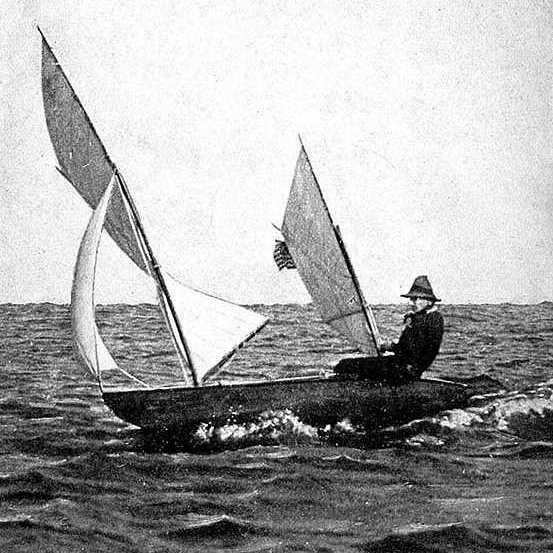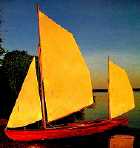ALONE IN THE CARIBBEAN
Being the Yarn of a Cruise in the Lesser Antilles
in the Sailing Canoe "Yakaboo"
BY FREDERIC A. FENGER
ILLUSTRATED
COPYRIGHT, 1917, BY FREDERIC A. FENGER
PRINTED IN THE UNITED STATES OF AMERICA
PREFACE
To most of us the West Indies comprise Cuba, Jamaica, Haiti or San Domingo (commonly thought to be two separate islands), Porto Rico and the smaller islands of the Bahamas, the Bermudas and Barbados, somewhere adrift off the Florida coast like a second Sargasso Sea. The lower Caribbees seem as mythical as the lost Atlantis itself. I feel that I shall have accomplished much if by means of a simple explanation and the use of a chart I can set the reader right for all time.
In general the West Indies include the Bahamas (a group of low-lying coral cays just across the Gulf Stream where it sweeps northward past the east coast of Florida) but more particularly they are those islands which stretch to the eastward from Yucatan to just beyond Porto Rico where they take a southward trend forming an almost perfect arc from the Virgins to Trinidad which is in reality the northeast corner of South America. Thus they bound the Caribbean Sea, on the north and east, which in the old days was also called the Northern Ocean in contradistinction to the Southern Ocean or Pacific which Balboa first saw directly to the south from the Isthmus of Panama. The large islands, Jamaica, Cuba, San Domingo and Porto Rico are known as the Greater Antilles while the smaller islands which take up the march to Trinidad are known as the Lesser Antilles. Of the Lesser Antilles, the Virgins, Anguilla, St. Martin, Barbuda, Saba, St. Eustatius, St. Kitts, Nevis, Antigua, Montserrat, Guadeloupe, Dominica and Martinique are known as the Leeward Islands; St. Lucia, St. Vincent, the Grenadines, Grenada, Barbados and Tobago are known as the Windward Islands.
The Bermudas form an entirely separate group quite distinct from the West Indies &endash; although their climate is semitropic &endash; and lie 750 miles ESE of Hatteras and some eight hundred miles from the nearest Bahamas.
The Lesser Antilles are apart from the rest of the West Indies in that the Spaniards played very little part in their colonization or development. While it is true that Columbus on his later voyages discovered the Lesser Antilles, a few of which he actually set foot upon and most of which he merely named as he saw them from a distance, the Spaniards made no attempts to settle on these small islands * and they lay unmolested for over a hundred years till early in the seventeenth century they were settled by the English, French and Dutch and a little later by the Danes. Aside from the patois of the Negro which varies more or less in the different islands, there are now but two languages spoken, English in the British, Dutch and Danish possessions and French in the French islands. For a time the Swedes owned St. Bartholomew which was ceded to France in 1878.
* With the exception only of Tobago.
The history of these small islands should be of interest to us on account of their early intimacy with our own colonies and especially because of the part which the Dutch island of St. Eustatius played in aiding us at the time of the Revolutionary War. But our knowledge of their early days is meager, hurricanes and the depredations of the little wood ant (which literally eats away the wooden houses from about their owners) being the two chief destroyers of manuscripts and their containers. What of the life of St. Eustatius scarcely eight miles in area -- which had its beginnings before our Plymouth colony and in 1781 when at the height of its prosperity it was destroyed by Rodney it had a population of nearly 40,000 -- more than either Boston or New York at that time?
Its printed history does not cover much more than 20,000 words. But with history we have little to do in this account. I have limited myself to those incidents which might have a direct interest for the reader and some of them, in whole or in part, as far as I can ascertain, now appear in print for the first time. Those who are familiar with the literature of the Lesser Antilles will, I hope, be agreeably disappointed in not finding in these pages those hardy perennials of the guide books -- the building of schooners at Bottom Town on Saba, eight hundred feet above the sea, and the deadly snakes of the Petit Piton that killed the members of a climbing party one by one till the last man fell only a few feet from his goal.
So I have attempted neither a history nor a guide book but have spun out the yarn of a lone cruise in a sailing canoe. I went to study the islands at first hand and in the craft which I believed would be most suitable for the purpose -- a deep-sea sailing canoe. The main portion of the cruise has appeared serially in abbreviated form in the "Outing" magazine.
I have made no attempt to discuss the problem of the native -- the more one studies it the less one has to say -- and my few explosions of choler will, I hope, be forgiven. Throughout the islands from Grenada to St. Thomas, I have made friends whom I count among my best and it is their unexampled courtesy and generosity that go to make up some of the most pleasant memories of the cruise. Those whom I would especially mention are C.V.C. Horne and T.B.C. Musgrave, who at once made me feel at home in St. George's and who, when they could not dissuade me from starting out in the Yakaboo, did everything in their power to facilitate my preparations for the cruise; Dr. William S. Mitchell, who loaned me his cotton ginnery; "Jack" Wildman, who helped me to much interesting material; "Steady" Glean, who rescued me from the mob at Sauteurs (but that is another story) ; Whitfield Smith, now at Grand Turk and whose place at Carriacou has been happily filled by Musgrave; McQueen, of pleasant memory of Top Hill days; Noel Walker -- I wonder if he has joined the ranks of the many who have "gone west"; Rupert Otway, whose hospitality I enjoyed at Union; "Old Bill" Wallace; V.J. Monplaisir, "Monty"; Captain Harry Turner, then Harbour Master of Castries and now in Mombasa; Père Remaud, I was going to say Labat; Monsieur Waddy and the whole of the "Union Sportive"; Mr. Frederick Woolworth, who took me in on faith and for whom I acted as cook in times of stress; Dr. John Morgan Griffith, enthusiast, of Statia; Captain "Ben" Hassel, "Freddie" Simmons, and Leslie Jarvis, Commissioner of Tortola.
F.A.F.
CONTENTS
I
THE YAKABOO IS BORN
AND THE CRUISE BEGINSII
WHALING AT ILE-DE-CAILLE
III
KICK 'EM JINNY
IV
CARRIACOU -- MAYERO -- BEQUIA
V
CLIMBING THE SOUFFRIERE OF SAINT VINCENT
VI
DAYS WITH A VANISHING RACE
VII
DELIGHTS OF CHANNEL RUNNING
VIII
MARTINIQUE
-- FORT DE FRANCEIX
ST. PIERRE & PELEE
X
A LAND CRUISE
-- THE CALM OF GUADELOUPEXI
WE MAKE OUR BEST RUN
XII
STATIA
-- THE STORY OF THE SALUTEXIII
SABA
XIV
SIR FRANCIS DRAKE'S CHANNEL AND YAKABOO
ILLUSTRATIONS
The "Yakaboo" (Frontispiece)
Course of the "Yakaboo"
Carénage, Grenada
Moored stern-to along the quay...
The market place, St. Georges.
Iron coal-pot of the West Indies
Jack's shack on Île-de-Caille where I made my home.
The "Ajoupa" -- a reminder of Carib days
In this channel from January to May, the humpback loafs on his way to the colder water of the North Atlantic.
The "Humpbacker" under sail
"Once more we had the weather berth and bore down on them under full sail, Bynoe standing high up on the 'box,' holding to the forestay"
Grenadine whaleboat showing bow and false-chock. The harpoon is poised in the left hand and heaved with the right arm.
"The immense intestines and bladders that looked like a fleet of balloons come to grief"
My camp at Mabouya
Loaded and ready to get off
On Carriacou -- looking north
"There had been one house in which the owner had lived on the top of the hill"
Cassava cakes drying on a roof at Mayero. Ruins of the old estate house of the St. Hilaires in the background.
Drying the cassava, Isle de Ronde
Preparing to leave Union. Walker sitting on the rail of his sloop and regarding Yakaboo doubtfully.
Coming back for repairs -- six men doing the work of two
The effect of the trade wind on the vegetation, Bequia
"Old Bill" and the skipper of the "Yakaboo"
"As I neared the shore I saw that the jetty was black with black people"
The usual appearance of the jetty, boat unloading for the market
Along the lee coast of St Vincent near Layou
My surly guides. Taken above the line of vegetation.
The Wallibu Dry River where we began the ascent. The Souffrière in the distance, its cone hidden in the mist.
How the Caribs rig a calabash for carrying water.
"A thousand feet below, held in the bowl of the crater, is a lake nearly a half mile in diameter"
Black Carib boy at Owia Bay. His catamaran is taxed at three pence per foot.
"There is still a satisfying amount of Indian blood left in these people"
The Carib boy of St. George's who had been brought to Grenada after the eruption of the Souffrière.
Yellow Caribs at Point Espagñol
"The camera got them just as they had slipped through the high surf"
Native canoe - St. Lucia.
Sunset -- St. Pierre
Hauling in the boat
The old guns at Fort Oranje, St. Eustatius. The date 1780 may be seen on the trunnion of the nearest gun.
"Here was a town walled in by Nature"
At the head of the Fort Ladder
"Here Freddie Simmons teaches embryo sailor-men, still in their knee trousers..."
The "dikes" of Bottom Town
Christian the Ninth -- St. Thomas
The jetty at Norman's Island
Appendix: More About Yakaboo and the Caribbean










































